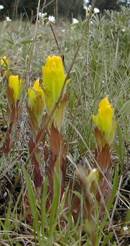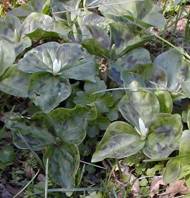With the decline of prairie habitat in South Puget Sound, several plant species are now rare and threatened with extinction. Each of these species has unique characteristics – adding to the diversity of our prairies.
 Golden Indian Paintbrush (Castilleja levisecta) Golden Indian Paintbrush (Castilleja levisecta) This small herb with its bright electric yellow flowers and modified leaf parts are a stunning addition to the prairie’s spring flower show. Golden Indian paintbrush occurs in Washington and British Columbia, with its largest population at the rocky Prairie Natural Area Preserve in southern Thurston County. Identification is not difficult; this is the only yellow paintbrush in South Puget Sound Prairies. The plant is a root parasite, getting some of its energy and nutrients from adjacent plants. Golden Indian Paintbrush is proposed as threatened with extinction by the U.S. Fish and Wildlife Service.
White-topped Aster (Aster curtus)
The White-topped Aster is a small non-descript aster. Although prevalent in the areas it occurs, the White-topped Aster is limited to the prairies and woodlands of South Puget Sound. White-topped Aster forms large dense clumps, formed by rhizomes. This vegetative reproduction may complement the late flowering period of the plant, when it is historically susceptible to burning by Native Americans. Identification of the White-topped Aster is easiest in the early fall, when the puffy seed heads give it away.
stand straight up, fading to purple as the flower ages. The flower sits directly on three leaves with no upper stem. The seed pods are plump, in the shape of hazelnuts and sit right on the junction of the three leaves. The jelly-like substance in the ripe seed pod contains a purple dye which can stain hands. The Small-flowered Trillium blooms around Easter time.
Torrey’s Peavine (Lathyrus torreyi)
This rare native of conifer woods grows less than a foot high and spreads its leaflets over an area the size of one’s hand. Lacking tendrils, it does not climb over, but is often dominated by its neighbors. Its blooms a pale blue-lilac colored flower. It was thought to be extinct in Washington until it was rediscovered on McChord Air Force Base in 1994. It occurs in openings in conifer forests on the edges of prairies.
 Small-flowered Trillium (Trillium parviflorum) Small-flowered Trillium (Trillium parviflorum)The Small-flowered Trillium is a showy forb found on the margins of prairies in the moist Oregon white-oak and mixed conifer hardwood forests. It is often found near other Northwest Native Trilliums, such as the Trillium ovatum. It needs shade and rich hummus soil. It normally grows to about twelve inches tall, though some may be taller. It has dark green, large leaves with darker mottled areas. Its petals are narrow and white.
Rose Checker-Mallow (Sidalcea maluiflora ssp. virgata)
The Rose Checker-Mallow is an upright, clump-forming perennial with rose-red flowers. This plant derives its common name from its flower bloom which is roughly the size of a checker game piece, spanning up to 1 ¼ inches across. Each plant forms a foot wide clump of round-lobed basal leaves. Its upright stems have deeply cut leaves topping off as a spike of mallow-flowers. It prefers partial shade and partial to full sun. As a wildflower, the species is native of high coastal meadows, and open woodlands, though it can also be found along roadsides, in open hills and other moist areas in the Northwest. It grows two to three feet in height and blooms in the spring and summer months.
Threats to Prairies and Their Rare Plants
-
Conversion to Residential or Agricultural Use
-
Establishment of Douglas Fir Forest
-
Invasion of Scotch Broom
Are You a Botanical Sleuth?
Several other rare plants species are known historically from our prairies, but have not been seen for years. If you are a botanical sleuth, you might want to keep your eyes open for these rare plants. Tall Agoseris (Agoseris elata) occurs in meadows and open woods from low-elevation to timberline west of the Cascade Mountains. Rose Checker-Mallow (Sidalcea malviflora ssp. virgata) was known from Scatter Creek Wildlife Area in Thurston County. The species occurs in disturbed areas, fields and roadsides, as well as, grassy hillsides in moist prairies. Common blue-cup (Githopsis speculariodes) is scattered in distribution and known from both sides of the Cascades.
|



